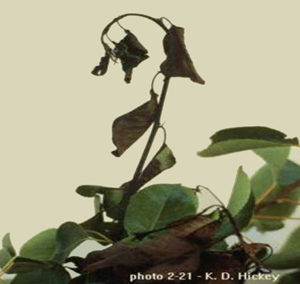Fireblight is a destructive, highly infectious, and widespread disease caused by the bacterium Erwinia amylovora. Fireblight can be a problem in Georgia and is particularly prevalent in some counties. Fire blight attacks blossoms, leaves, shoots, branches, fruits, and roots. Here are some facts and methods to help you avoid and control the disease.
Hosts
The disease affects plants in the Rosaceae family, which includes trees and shrubs in orchards, nurseries and landscape plantings. The plants affected include Amelanchier (serviceberry), Chaenomeles (flowering quince), Cotoneaster (cotoneaster), Crataegus (hawthorn), Eriobotrya (loquat), Malus (apple and crabapple), Photinia (photinia), Prunus (flowering almond, plum and cherry), Pyracantha (pyracantha), Pyrus (pear), Rosa (rose), and Spiraea (spirea).
 Figure 1. Shephard's crook, a typical symptom of fireblight.
Figure 1. Shephard's crook, a typical symptom of fireblight.Disease Symptoms
The bark at the base of blighted twigs becomes water soaked, then dark, sunken, and dry; cracks may develop at the edge of the sunken area. Young twigs and branches die from the terminal end and appear burned or deep rust colored. Branches may be bent, resembling what is commonly referred to as a “shepherd's crook” (Figure 1). Dead leaves and fruit remain on the branches.
Disease Cycle
Initially the disease often enters the tree through natural openings, especially flowers and wounds in the spring. Once established in the tree, fireblight quickly invades through the current season's growth into older growth.
Fireblight can be spread from diseased to healthy plants by rain, wind, and pruning tools. The bacterium can survive the winter in sunken cankers on infected branches. In spring, the bacteria ooze out of the cankers and attract bees and other insects. Insects also help spread the disease to healthy plants. The bacteria spread rapidly through the plant tissue in warm temperatures (65 °F or higher) and humid weather.
Disease Management
During spring and summer, prune out infected branches 8 in. below the damage. Avoid pruning when the plants are wet. Dip pruning tools in 70% isopropyl alcohol (rubbing alcohol) or a 10% bleach solution (1 part bleach to 9 parts water solution) between each cut. Wash and oil shears when you are finished. These practices avoid spreading the pathogen.
Avoid heavy nitrogen fertilization, especially in summer, when succulent growth is most susceptible to fireblight infection. Avoid splashing water. Chemical control is not always effective and needs to be applied preventively. Therefore, in years when warm, humid, wet weather coincides with flowering and leaf emergence, spray plants with a fungicide containing basic copper sulfate (Kocide) or an antibiotic (Agrimycin) to reduce infection. Applications of Agrimycin need to begin at the start of blooming and continue every 3-4 days during the bloom period. Application of Kocide should begin at bloom and continue every 7 days during bloom. Re-application following rain may be needed.
There are varieties of these plants that are resistant to the disease; plant one of these varieties instead of a more susceptible variety.
Some Resistant or Tolerant Plants
Pyracantha — Laland’s firethorn
Hawthorn — Washington hawthorn
Pear — Kieffer, Moonglow, Orient, Seckel
Apple — Enterprise, Freedom, Liberty, Prima, Priscilla, etc.
Crabapple — Adams, Dolgo, Jewelberry, Liset, etc.
Status and Revision History
Published on Oct 15, 2004
Published on Feb 10, 2009
Published on May 05, 2009
Published with Full Review on May 05, 2012
Published with Full Review on Mar 28, 2017
Published with Full Review on May 08, 2023


























































